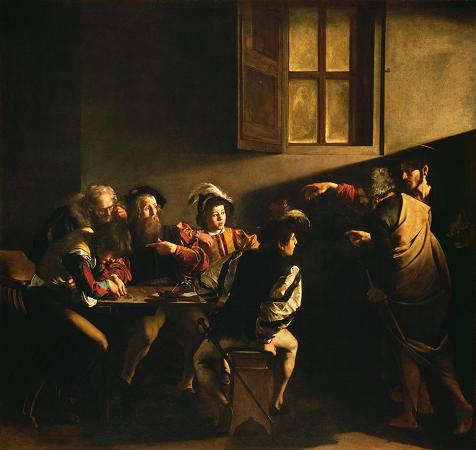Martyrdom of Saint Peter (c1605). Oil on canvas. 230 x 175. The Crucifixion of Saint Peter is a work by Michelangelo Merisi da Caravaggio, painted in 1601 for the Cerasi Chapel of Santa Maria del Popolo in Rome. Across the chapel is a second Caravaggio work depicting the Conversion of Saint Paul on the Road to Damascus. On the altar between the two is the Assumption of the Virgin Mary by Annibale Carracci. The two lateral paintings were commissioned in September 1600 by Monsignor Tiberio Cerasi, Treasurer-General to Pope Clement VIII who purchased the chapel from the Augustinian friars on 8 July 1600 and commissioned Carlo Maderno to rebuild the small edifice in Baroque style. The contract for the altarpiece with Carracci has not been preserved but it is generally assumed that the document had been signed somewhat earlier, and Caravaggio had to take into consideration the other artist's work and the overall iconographic programme of the chapel. Cerasi nourished a deep devotion towards Saint Peter and Paul, and invoked them in his will. Together the two saints represented the foundation of the Catholic Church, and they were called the Princes of the Apostles. Both had a strong connection to the city of Rome and the papacy. Caravaggio's paintings were thus intended to express Cerasi's attachment to the Church of Rome and his closeness to papal power. Their position in the chapel was important but the devotional focus was still on the Assumption of the Virgin Mary on the altar in the middle. The juxtaposition of the two scenes had a well-known precedent in the frescos of the Capella Paolina at the Apostolic Palace but the paintings of Caravaggio were starkly different from the crowded Mannerist scenes of Michelangelo. Although much has been said about the supposed rivalry between Carracci and Caravaggio, there is no historical evidence about any serious tensions. Both were successful and sought-after artists in Rome. Caravaggio gained the Cerasi commission right after his celebrated works in the Contarelli Chapel had been finished, and Carracci was busy creating his great fresco cycle in the Palazzo Farnese. In these circumstances there was little reason for them to regard each other as business rivals, states Denis Mahon. The contract signed on 24 September 1600 stipulates that the distinguished painter, Michelangelo Merisi da Caravaggio will paint two large cypress panels, ten palms high and eight palms wide, representing the conversion of Saint Paul and the martyrdom of Saint Peter within eight months for the price of 400 scudi. The contract gave a free hand to the painter to choose the figures, persons and ornaments depicted in the way as he saw fit, to the satisfaction however of his Lordship, and he was also obliged to submit preparatory studies before the execution of the paintings. Caravaggio received 50 scudi as advance payment from the banker Vincenzo Giustiniani with the rest earmarked to be paid on completion. The dimensions specified for the panels are virtually the same as the size of the existing canvasses. When Tiberio Cerasi died on 3 May 1601 Caravaggio was still working on the paintings as attested by an avviso dated 5 May which mentioned that the chapel was being decorated by the hand of the famosissimo Pittore, Michelangelo da Caravaggio. A second avviso dated 2 June proves that Caravaggio was still at work on the paintings a month later. He completed them sometime before 10 November when he received the final instalment from the heirs of Tiberio Cerasi, the Fathers of the Ospedale della Consolazione. The total compensation for the paintings was reduced to 300 scudi for unknown reasons. The paintings were finally installed in the chapel on 1 May 1605 by the woodworker Bartolomeo who received four scudi and fifty baiocchi from the Ospedale for his work. The first version Giovanni Baglione in his 1642 biography about Caravaggio reported that the first versions of both paintings were rejected: The panels at first had been painted in a different style, but because they did not please the patron, Cardinal Sannesio took them; in their place he painted the two oil paintings that can be seen there today, since he did not use any other medium. And-so to speak-Fortune and Fame carried him along. This report is the only historical source for the well-known story. Although the biography was written decades after the events, its veracity has generally been accepted. Baglione provided no further explanation about the reasons and circumstances of the rejection but modern scholarship put forward several theories and conjectures. The first versions of the paintings were obviously acquired by Giacomo Sannesio, secretary of the Sacra Consulta and an avid collector of art.
more...




